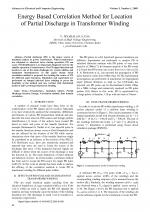| 1/2009 - 8 |
Energy Based Correlation Method for Location of Partial Discharge in Transformer WindingJEYABALAN, V., USA, S. |
| View the paper record and citations in |
| Click to see author's profile in |
| Download PDF |
Author keywords
transformers, insulation failure, partial discharge location, energy, correlation method, time domain correlation
References keywords
partial(10), discharge(9), insulation(6), tdei(4), dielectric(4)
Blue keywords are present in both the references section and the paper title.
About this article
Date of Publication: 2009-02-03
Volume 9, Issue 1, Year 2009, On page(s): 46 - 51
ISSN: 1582-7445, e-ISSN: 1844-7600
Digital Object Identifier: 10.4316/AECE.2009.01008
Web of Science Accession Number: 000264815300008
SCOPUS ID: 67749107974
Abstract
Partial discharge (PD) is the major source of insulation failure in power transformer. When transformers are subjected to electrical stress during operation, PD can occur. PD identification is an important diagnostic tool for the reliable operation of transformers. The PD signal detection and location is one of the main challenges for system utilities and equipment manufacturers. In this paper energy based correlation method is proposed for locating the source of PD for different pulse durations. Simulation and experiment are performed on lumped physical layer winding to prove the feasibility of the method and also verified with distributed model of 22kV prototype interleaved winding. |
| References | | | Cited By |
Web of Science® Times Cited: 1 [View]
View record in Web of Science® [View]
View Related Records® [View]
Updated 3 days, 2 hours ago
SCOPUS® Times Cited: 2
View record in SCOPUS® [Free preview]
View citations in SCOPUS® [Free preview]
[1] Multi-end correlation-based PD location technique for medium voltage covered-conductor lines, Isa, M., Elkalashy, N. I., Lehtonen, M., Hashmi, G. M., Elmusrati, M. S., IEEE Transactions on Dielectrics and Electrical Insulation, ISSN 1070-9878, Issue 3, Volume 19, 2012.
Digital Object Identifier: 10.1109/TDEI.2012.6215097 [CrossRef]
[2] Least deviation methods for location of partial discharge in transformer windings, Jeyabalan, V., 2010 Joint International Conference on Power Electronics, Drives and Energy Systems & 2010 Power India, ISBN 978-1-4244-7782-1, 2010.
Digital Object Identifier: 10.1109/PEDES.2010.5712489 [CrossRef]
Disclaimer: All information displayed above was retrieved by using remote connections to respective databases. For the best user experience, we update all data by using background processes, and use caches in order to reduce the load on the servers we retrieve the information from. As we have no control on the availability of the database servers and sometimes the Internet connectivity may be affected, we do not guarantee the information is correct or complete. For the most accurate data, please always consult the database sites directly. Some external links require authentication or an institutional subscription.
Web of Science® is a registered trademark of Clarivate Analytics, Scopus® is a registered trademark of Elsevier B.V., other product names, company names, brand names, trademarks and logos are the property of their respective owners.
Faculty of Electrical Engineering and Computer Science
Stefan cel Mare University of Suceava, Romania
All rights reserved: Advances in Electrical and Computer Engineering is a registered trademark of the Stefan cel Mare University of Suceava. No part of this publication may be reproduced, stored in a retrieval system, photocopied, recorded or archived, without the written permission from the Editor. When authors submit their papers for publication, they agree that the copyright for their article be transferred to the Faculty of Electrical Engineering and Computer Science, Stefan cel Mare University of Suceava, Romania, if and only if the articles are accepted for publication. The copyright covers the exclusive rights to reproduce and distribute the article, including reprints and translations.
Permission for other use: The copyright owner's consent does not extend to copying for general distribution, for promotion, for creating new works, or for resale. Specific written permission must be obtained from the Editor for such copying. Direct linking to files hosted on this website is strictly prohibited.
Disclaimer: Whilst every effort is made by the publishers and editorial board to see that no inaccurate or misleading data, opinions or statements appear in this journal, they wish to make it clear that all information and opinions formulated in the articles, as well as linguistic accuracy, are the sole responsibility of the author.





